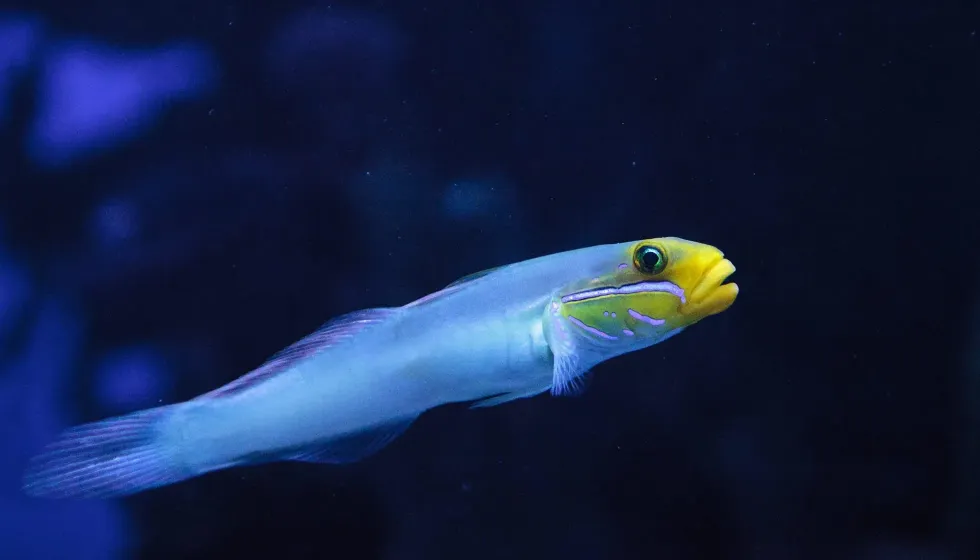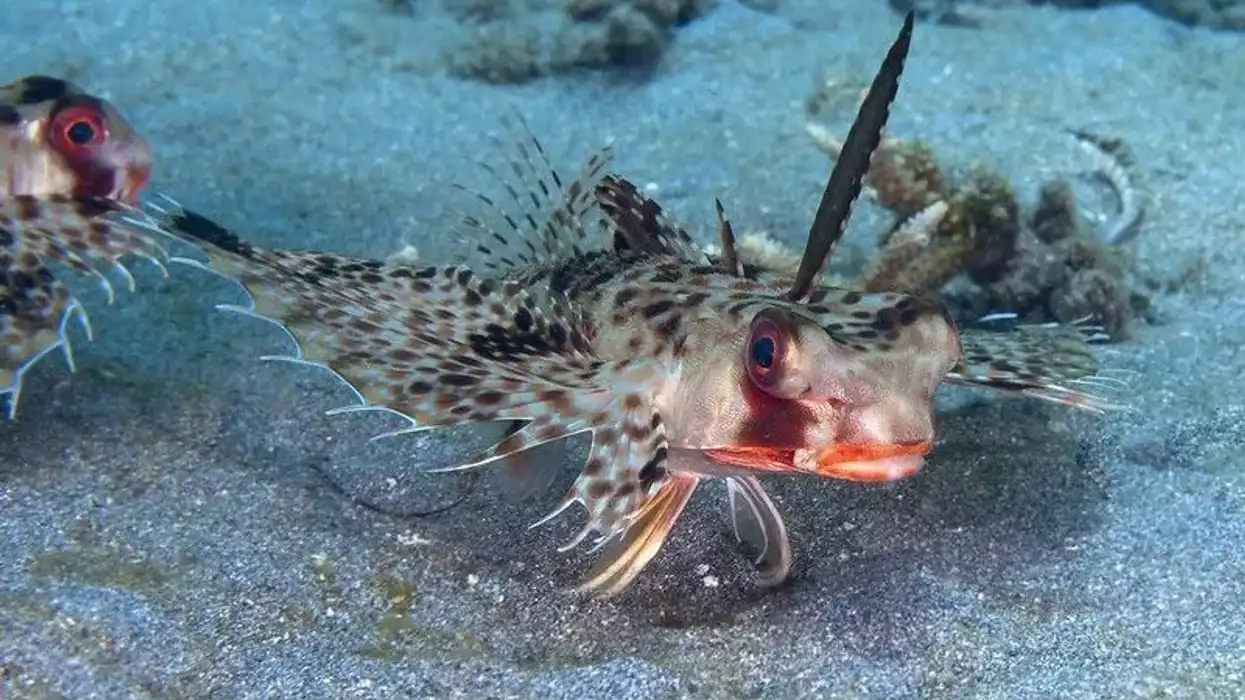The sleeper gold head goby is also known by different names, including the yellow-headed sleeper goby, Bluestreak, pennant glider (yellowheaded) or golden head sleeper or blueband.
When you watch this goby species, you will understand why it is called yellow-headed or golden head fish as its head is yellow gold with a sapphire blue stripe just under its eyes, and the rest of the body is off-white.
The aquatic world is filled with such amazing colorful creatures.
The scientific name of the golden-headed sleeper goby is Valenciennea strigata and it prefers to live in or around corals. An interesting thing about this sleeper gold head goby is that it is excellent at sifting sand.
It takes mouthfuls of sand and dumps on all the rocks and benthic invertebrates by expelling the sand from its gill openings.
It helps in cleaning your sand bed in the aquariums. It is available in different habitats such as sand, rubble, and complexes, but the primary habitat of these gobies are caves dug under the rubble.
To know more information about this golden-headed sleeper goby fish, go through the detailed content below. For similar species, check the orange angelfish and the piranha on Kidadl!
Gold Headed Goby Interesting Facts
What type of animal is a gold-headed goby?
The gold-headed goby is a fish species that belongs to the Gobiidae family. These fish belong to the Gobi family and are small-medium-sized ray-finned fishes located in brackish, marine, and freshwater environments. There are 2200 species of goby fishes in the Gobiidae family.
What class of animal does a gold-headed goby belong to?
The gold-headed goby or golden-head sleeper goby fish belongs to the Actinopterygii class and genus Valenciennea. The members of this class are also called ray-finned fish. Fish belonging to the genus Valenciennea are often found in corals.
How many gold-headed gobies are there in the world?
The exact number of pennant glider yellow-headed fishes worldwide is unknown, but it has moderate demand as aquarium fish.
Where does a gold-headed goby live?
The gold-headed goby fish is found in the Indian and Western Pacific Oceans. It is located in countries like Africa, Fiji, Indonesia, Solomon Islands, Sri Lanka.
What is a gold-headed goby's habitat?
The habitats of goby Valenciennea strigata is in corals, outer lagoons, sandstone, and rock reefs and on coral rubble habitats and spends most of its time on the bottom sifting sand at the depths of 3.3-82 ft (1-25 m) at the marine temperatures and features ranging pH 8.1-8.4, sg 1.020-1.025, dKH 8-12, and 72-78 F (22.2-28.5 C).
Who does gold-headed goby live with?
They are peaceful fish species observed to be living in groups or pairs where space and filtration are abundant. The group of fish is called a school. Juveniles like to burrow in the sand. Some of the aquarists mention that in captivity, just like other goby species, it may become aggressive towards fellow sleeper gobies.
How long does a gold-headed goby live?
The lifespan of yellow-headed sleeper goby fish is unknown. However, the general lifespan of goby fishes ranges from 1-10 years; species living in warmer conditions may have more chances of survival.
How do they reproduce?
Not much is known about its reproduction process; generally, the Gobiidae family species lay eggs on the substrate. The yellow-headed or golden head fish lays its eggs in the burrows dug under the rubble.
Males take care of young ones, and females take care of burrows or caves. The transparent larvae are carried away downstream and return to the freshwater environment weeks or months later.
What is their conservation status?
The conservation status of the golden head sleeper or blue band fish is not evaluated.
Gold Headed Goby Fun Facts
What does a gold-headed goby look like?
The sleeper goby is a marine water fish that is not colorful, but yes, the head and face part has distinctive colors, which help in identification. The body of the yellow-headed sleeper goby is in white with a yellow head and flashing blue band extending horizontally from the corner of the mouth to the gill cover.
How cute are they?
The yellow-headed sleeper goby is a peaceful and active bottom-dweller aquatic animal. Though not colorful like other fish species, the yellow-colored head with a blue band draws your attention.
Its activities in the aquarium environment make all the stones and gravels lying on every corner of the aquarium. And one of the advantages of this fish is it is easy to maintain fish in the aquariums.
How do they communicate?
The common ongoing habit of gold-headed sleeper gobies is chewing the sand. Headed sleeper gobies can communicate with each other by producing signals with their mouths.
How big is a gold-headed goby?
The yellow-headed sleeper goby or gold-headed goby reaches a maximum length of 7 in (18 cm). Its length is three times less than the tank goby, whose maximum length is 20 in (50 cm).
How fast can a gold-headed goby swim?
The exact speed of gold-headed goby is not found in any sources or research papers. However, these bottom dwellers that associate with the bottom or substrate are usually slow swimmers.
How much does a gold-headed goby weigh?
The weight of golden-headed sleeper goby, blue-banded goby, or pennant glider is unknown, but the adults may grow up to 7 in (18 cm) in the wild, which is twice the size of the angelfish.
What are the male and female names of the species?
The male and female names of the marine gold-headed goby are male gold-headed goby and female gold-headed goby.
What would you call a baby gold-headed goby?
The baby of the golden head sleeper goby is called offspring.
What do they eat?
The yellow-headed goby (Valenciennea strigata) eats large mouthfuls of sand and sifts it, eating small invertebrates and other tiny marine organisms. This goby also thrives on frozen foods.
Yellow-headed sleeper gobies prey on small crustaceans, a variety of brine shrimp, live blackworms, and mysid shrimp. In an aquarium, live brine and high-protein krill are the best options.
Are they poisonous?
In general, gobies are not poisonous or dangerous; some countries prefer gobies in their diet. But Gobiodon citrinus is one species of goby that is poisonous; they produce poisonous mucus.
Would they make a good pet?
Yes, this active and beautiful fish serves as a good pet. This gold-headed sleeper goby is a peaceful species.
Gold-headed sleeper goby care involves a moderate level of attention. This independent fish is a territorial one that rarely becomes aggressive towards other fish species. It can be kept as a single or grouped as a mated pair.
It should be housed in a 30 gal (113.5 l) or larger aquarium filled with sand as the substrate and attached populated refugium, a well-sealed canopy to be provided. It should be fed frequently with varieties of live or frozen shrimp, and live blackworms.
Understanding the water chemistry, selection of tank size, avoiding aggressive fishes as tank mates, and a proper feeding timetable are recommended while taking care of goby species.
Did you know...
Goby-sized fish will be the best tankmate for Gold-headed goby.
Almost all the goby species are bottom-dwellers or burrowers, where they efficiently use their mouths to dig the sea bottoms and shift the sand from their burrows. They live in the benthic zone and dwell at the bottom of the tanks for food.
Their digging quality improves the health of the aquarium. The best sand sifting goby that keeps the sand bed clean is diamond goby – Valenciennea puellaris.
No reports exist to suggest if goby fishes bite. But one of the subfamilies of the Gobiidae family, the worm gobies, bite when caught, though the bite is not dangerous.
Do humans eat them?
Yes, people in countries like China prefer to eat these tiny fish. People in coastal China eat the gobies by mixing various species like viscera and gonads. Of all the species, it is not recommended to eat round gobies.
Are gobies aggressive?
In general, gobies are peaceful and calm aquatic creatures but may become aggressive when pairing up with similar or other species of fish. Because of their territorial nature, the gobies are sometimes considered aggressive, which is not entirely true.
Bumblebee gobies are also considered as aggressive. But as per some fish enthusiasts, no issue is detected in placing two gobies in one tank.
Here at Kidadl, we have carefully created lots of interesting family-friendly animal facts for everyone to discover! Learn more about some other fish from our herring interesting facts and Marlin facts pages.
You can even occupy yourself at home by drawing one on our free printable gold-headed goby coloring pages.









